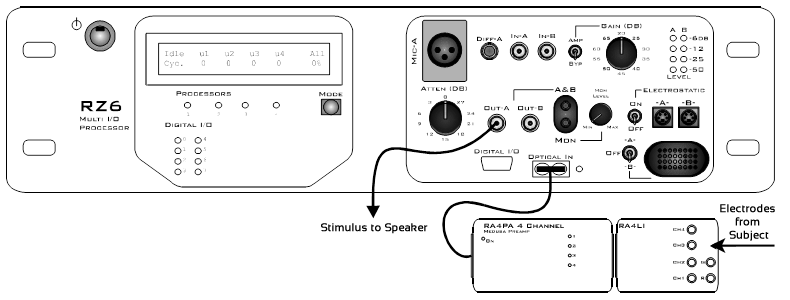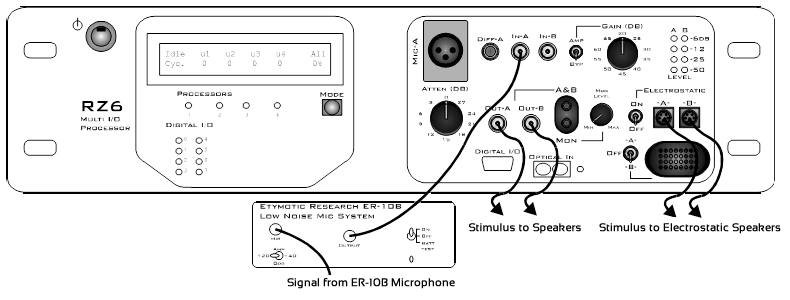Overview
Welcome to BioSigRZ, TDT's RZ6 compatible stimulus presentation and data acquisition package for ABR and DPOAE screening and research studies.
What Is BioSigRZ?
BioSigRZ is a powerful, yet easy-to-use, tool designed to automate the process of presenting stimulus signals and acquiring response signal data. BioSigRZ works with the RZ6 Multi I/O processor and supports stimulus customization using TDT's signal design software, SigGenRZ.
BioSigRZ Capabilities and Features
-
Standard configurations for ABR and DPOAE
-
Standard speaker and microphone profiles
-
Stimulus schedule customization
-
Stimulus variable customization
-
Dual-channel stimulus
-
Artifact rejection
-
Averaging
-
Stimulus schedule override
-
Historical data display
-
Comparison data display
-
Calculator
-
Detail display
-
Cursors
-
Report generation
-
SigGenRZ file support
Standard Configurations for ABR and DPOAE
Standard configuration files enable you to run ABR and DPOAE screening protocols out-of-the box with little or no software configuration beyond basic installation.
Standard Speaker and Microphone Profiles
Standard speaker and microphone profiles are provided for TDT speakers and microphones typically used with the RZ6. In most cases a profile can be selected and no further calibration is required.
Stimulus Schedule Customization
Standard or custom stimulus files include a stimulus schedule that specifies how variables change during stimulus presentation. The stimulus can be presented over multiple intervals with signal parameters varied as a function of each interval.
The SigGen Index (SGI) is another name for the interval number. You may customize the SGI from within BioSigRZ.
Stimulus Variable Customization
BioSigRZ supports direct customization of stimulus variables such as frequency, level, and attenuation.
Dual-Channel Stimuli
BioSigRZ enables you to present dual-channel stimuli.
Artifact Rejection
BioSigRZ's artifact rejection provides a means for rejecting signals with anomalous amplitude values.
Averaging
BioSigRZ maintains a running average that you can view as signals are acquired. Averaging continues until the desired number of signals is acquired.
Stimulus Schedule Override
BioSigRZ provides several command functions that allow you to manually override the stimulus schedule during stimulus presentation. These functions include: Advance, Skip, Repeat, and ReDo.
Historical Data Display
As averages are completed, resulting waveforms are displayed in a history plot and are appended to a file known as the BioSigRZ Record file (.arf file).
Comparison Data Display
You can compare historical data records with newly acquired records.
Calculator
Using a built-in calculator, you can perform a variety of mathematical operations on acquired data.
Detail Displays
You may view any record in more detail. BioSigRZ provides two detailed displays: a detailed Time-Domain Plot and a corresponding Frequency-Domain Plot. You can zoom-in on any portion of either display.
Cursors
BioSigRZ allows you to obtain information about instantaneous level at various points in time through the use of cursors.
Report Generation
You can generate custom reports consisting of historical signal data. A worksheet area of the BioSigRZ main window can be used to build these reports.
SigGenRZ File Support
BioSigRZ takes advantage of the powerful signal generation capabilities of TDT's signal design software, SigGenRZ. BioSigRZ reads SigGenRZ files (.sig files) and uses the signal parameters stored in these files to generate stimulus signals over successive SigGenRZ Indices (SGIs). Most users will not need to work directly with SigGenRZ, however, it provides a means of designing custom stimuli.
How to Use BioSigRZ
BioSigRZ is designed to collect and analyze data such as auditory brainstem response (ABR) data and distortion product otoacoustic emission (DPOAE) data. It enables you to acquire and process bioelectric signal data in response to a stimulus signal.
Workflow for Initial Experiment Set-Up
Most users will use BioSigRZ as follows:
-
Load a pre-existing Configuration file provided with BioSigRZ.
-
Select your transducers and microphones. This step ensures your system will be calibrated for your speakers and microphones. No manual calibration is required.
-
If needed, modify the pre-existing stimulus variables.
-
Save the BioSigRZ configuration with a new name.
Saving the file, saves any modification you have made to the experiment configuration, stimulus, and variables. When you are ready to run the experiment it is as simple as loading the file, specifying a record file where data will be saved, and collecting the data.
BioSgRZ also supports complete customization of the configuration or stimuli for users who require it. For users who wish to design custom stimuli, see the SigGenRZ Manual.
Workflow for Daily Operation
Once your experiment hardware and software configuration is established, you can use BioSigRZ as follows:
-
Load your BioSigRZ configuration file (created above).
-
Prepare the subject.
-
In BioSigRZ, specify a Response Record File where data will be stored for the current trial or subject.
-
Begin averaging and data collection.
-
End data collection, then process and Analyze the response data.
Standard BioSigRZ Configuration Files
BioSigRZ provides standard configuration files in the C:TDT\BioSigRZ\Configs folder:
-
ABR\Root_ClickAbr.acf - A 0.1 millisecond, single-channel mono-phasic click will be presented. With each successive presentation, the click phase will alternate between a condensation and rarefaction click. Click level will vary from 90 dB SPL to 10 dB SPL in 10 dB decrements. A single channel acquires the response through the use of an RA4PA preamplifier via the RZ6 fiber optic port. A total of 512 responses will be averaged at each level.
-
ABR\Root_ToneAbr.acf - A five millisecond, single-channel tone with a 3 millisecond gate time will be presented at the following frequencies: 4000 Hz, 8000 Hz, and 16000 Hz. For each frequency, the tone level will vary from 90 dB SPL to 20 dB SPL in 10 dB decrements. With each successive presentation, the tone phase will alternate 180 degrees to reduce artifacts. A single channel acquires the response through the use of an RA4PA preamplifier via the RZ6 fiber optic port. A total of 512 responses will be averaged at each frequency and level combination.
-
DPOAE\Root_DPOAE.acf - Distortion-product otoacoustic emission (DPOAE) data will be collected in response to a combination tone presented continuously. The integrity of the cochlea will be measured at the following audiometric frequencies: 4000 Hz, 8000 Hz, 16000 Hz, and 32000 Hz. The frequencies of Channel A and Channel B will be geometrically centered about the audiometric frequency. That is, the frequency of Channel A (F1) will be the audiometric frequency multiplied by a factor of 0.909 and the frequency of Channel B (F2) will be the audiometric frequency multiplied by a factor of 1.09, so that F2/F1 = 1.2. The level of the two primary tones will remain equal and will vary from 80 dB SPL to 20 dB SPL in 10 dB decrements. A single channel microphone response is acquired using the RZ6 In-A connector.
System Requirements
In order to run BioSigRZ, you must have the following:
-
Computer running Windows XP Service Pack 3, Windows 7, or Windows 10.
-
TDT drivers (72 or higher)
-
Super VGA (1024 x 768) resolution graphics (or higher)
-
RZ6 Multi I/O processor
-
Optibit Interface Card in your PC to communicate with RZ6
Hardware Configuration
BioSigRZ works with TDT's powerful RZ6 Multi I/O processor to acquire and average signals and to view signal responses to complex stimulus patterns. All acquisition and signal generation are performed using a single RZ6 processor. Typical configurations for ABR and DPOAE are shown in the diagrams below.
Typical ABR Configuration

In a typical configuration for ABRs the RZ6 provides digital to analog conversion to drive the speaker stimulus, and an RA4PA preamp and RA4LI headstage acquire the subject data. In newer systems, the Medusa4Z replaces the RA4PA/RA4LI combination for electrode signal acquisition. The RZ6 provides programmable and manual attenuation for stimulus channel A and drives a single speaker to present the stimulus. Other device outputs can be used to support alternative transducers.
Typical DPOAE Configuration

In a typical configuration for DPOAEs the RZ6 provides stimulus generation, programmable and manual attenuation for two stimulus channels and drives either two electrostatic speakers or other speakers to present the stimulus.
When not using the electrostatic speakers use Out-A and Out-B, these outputs and the stereo A&B headphone output can be used to support other transducers, such as the ER2C from Etymotic.
Response acquisition is handled by the ER-10B microphone system from Etymotic while analog to digital conversion is performed on the RZ6 through ADC channel In-A.
BioSigRZ File Types
BioSigRZ uses or writes to seven types of files:
-
BioSigRZ configuration files (*.acf)
-
SigGenRZ files (*.sig)
-
Calibration files (*.tcf)
-
BioSigRZ response record files (*.arf)
-
BioSigRZ worksheet files (*.awf)
-
ASCII text files (*.txt)
-
CSV files (*.csv)
Important
Some operating system configurations have file name and path character limitations. TDT recommends keeping file names, including path, short to avoid problems associated with long file names.
BioSigRZ Configuration Files
Stimulus and data acquisition parameters are saved as part of the BioSigRZ configuration file. The extension for BioSigRZ configuration files is .acf.
SigGenRZ Files
Standard stimulus files are provided with BioSigRZ and specification of the appropriate file is preconfigured in each of the standard configuration files. Stimulus signals are designed with TDT's signal generation package, SigGenRZ. BioSigRZ uses information saved in a SigGenRZ file to reconstruct the stimulus signal and vary it according to defined variables. The extension for SigGenRZ files is .sig.
Calibration Files
Standard calibration files for common speakers and microphones are provided with BioSigRZ. If a calibration file is not provided for your specific model, contact TDT for assistance. Prior to presenting a stimulus signal or acquiring data, you may specify calibration file(s) for your hardware. The extension for calibration files is .tcf.
BioSigRZ Record Files
For every stimulus interval, or SigGenRZ Index (SGI), BioSigRZ acquires response signals and computes an average. The resulting averaged waveforms are collectively stored in a BioSigRZ record file. These waveforms may be retrieved for analysis in later sessions. Waveforms retrieved from BioSigRZ record files are displayed in a history plot. The extension for these files is .arf.
BioSigRZ Worksheet Files
BioSigRZ allows you to build custom reports. Custom reports are created by placing desired historical plot records into a worksheet plot. These reports may be saved in BioSigRZ Worksheet files. The extension for these files is .awf.
ASCII Text Files
You may wish to export BioSigRZ record information to an ASCII text file for use by another application. BioSigRZ allows you to export record information in ASCII text format. These files are saved with the extension, .txt.
CSV Spreadsheet Files
BioSigRZ allows you to export raw trace data with descriptions into a standard spreadsheet file (CSV files). Each row in the spreadsheet file contains all of the data for one record.